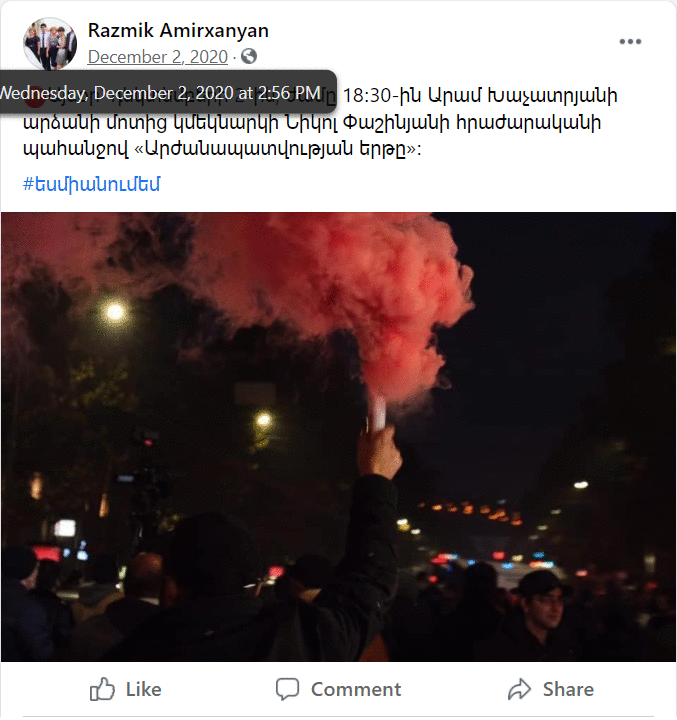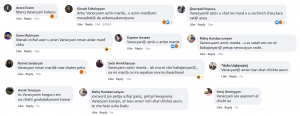The leader of the Homeland Party Arthur Vanetsyan called Prime Minister Nikol Pashinyan a “fake” during a rally in Freedom Square on December 5, 2020.
“Nikol Pashinyan has consistently destroyed the real state, building a virtual Armenia instead,” Vanetsyan stated, adding that “in the virtual homeland it is not the life of a real person that is valued, but the seeming approval, the liking.”
This statement is not the only case when politicians accuse each other of having an army of fakes and imitating broad public support.
In recent months, the Fact Investigation Platform has investigated and revealed the activities of fake accounts run by or affiliated with various politicians on social networks.
First, we will present the “army” of fake accounts working in favor of the former head of the National Security Service Arthur Vanetsyan on Facebook and Twitter.
As a result of the monitoring by the Fact Investigation Platform, an “army” of fakes was disclosed on Facebook. This group consists of at least 160 user accounts. This number is not final, and we cannot rule out that it is much bigger. The connection and coordination between these fake pages is proven by a number of commonalities. Only the fake accounts that operate at the moment have been studied. It is not ruled out that there were previously operated but currently inactive accounts, the detection of which is difficult or even impossible.
Page content
Thus, these user accounts share the same publication on the same day, almost at the same time, and we can say that in just a few minutes, a specific publication has several dozen, even a hundred, likes and shares by this “army”. For example, within minutes, 98 members of this “army” shared a video on a Facebook page called Anonymous, which calls for joining the post-war rallies of 17 parties. Another example is the statement of the Legal Way NGO co-founded by former Artsakh Human Rights Defender Ruben Melikyan, who joined the 17-party movement. It was shared by 108 members of this army.
There are many examples, and a quick study of the pages gives the impression that we are on the same person’s page, the only difference being that the usernames and profile pictures are different.
“Personal” photos
From the study of fake photos, we found out that they have a certain principle of uploading. Most fake accounts have 2-3 “personal” photos posted on the same day. These are mostly personal photos of users of Russian social networks, but there are also photos stolen from Armenian users.
Below you can see the real owners of the fake photos.
As for the friend lists, they mostly coincide. Moreover, these fakes are also in each other’s friend lists.
Their creation
Since it is no longer possible to find out the exact date of creation of the account on Facebook (most of that information is not visible), we tried to use another method to understand when these fakes first became active on their pages. We took the date of posting the profile photo in the user account as a basis. As we have already mentioned, the fakes posted their “personal” photos on the same day. And if, for example, there are two photos, in one of which the person is in winter, in the other in summer clothes, but both are posted on the same day, it is at least strange and raises questions. And this is what gives reason to suppose that the date of posting the photos most likely coincides with the creation of the user account. Using this method, we found out that about 90% of the “army” of fakes posted their profile pictures in January-April and August 2020, that is, the accounts were opened during the mentioned period.
Shared photos
Most of the fakes shared the same photos at the same time, with the same caption or hashtag. One of those pictures is the screenshot confirming the decrease of Nikol Pashinyan’s Facebook page likes, which was circulated on 108 fake pages. The screenshot showing the same number of likes was circulated with the same caption. It was shared on the night of November 29, mainly in the period between 00:20 and 01:00am.
Pay attention to the GIF animation posted below, where we showed the picture shared by fakes. As you can see, only the user and the time of publication change, and the screenshot and the caption remain unchanged.
Pay attention to account names and posting time.
Another picture, which referred to the march of 17 parties on December 2, was posted by 112 fake accounts. The caption and hashtag are the same again. And the picture was shared mainly on December 2, between 15:00 and 15:45.
In this GIF animation as well, only the user and the time of publication change, while the photo and the caption are the same, as in the previous case.
110 of these fakes posted a picture demanding Nikol Pashinyan’s resignation on their page on November 26, from 12:00 to 13:30.
Note again that only the username/picture and the time of publication change.
In contrast to the previous two cases, in the case of this photo, some of the fakes simply shared it, while others captioned it “RESIGNATION”.
Again, pay attention to account names and posting time.
Liked pages
The Facebook pages liked by fakes and their similarity are striking. Almost everyone could find only a few liked pages, among which are “Hraparak” daily and I-lur. The latter was launched on June 6 last year, sharing photos, publications humiliating the current authorities, as well as the words of the opposition parties and figures. Among them, statements of the representatives of Prosperous Armenia Party and Homeland Party, mostly their leaders, stand out.
Who do they work for?
At first glance, this organized ” army of fakes” is notable for its anti-government posts, but a closer look has led us to believe that the fake “army” is being run to support Arthur Vanetsyan, the founder of the Homeland Party, and to target his political opponents.
It should be reminded that Vanetsyan was dismissed from the post of NSS director in September 2019.
At the end of November 2019, he founded the Homeland Development Fund, and in February 2020, the party with the same name was founded, positioning itself in the opposition field.
As we have shown above, this large group of fakes operates in a very systematic way, sharing the same posts and pictures with exclusively political content. However, the actions of some members of the fake army made it possible to find their connection with Arthur Vanetsyan.
Thus, some members of the fake army posted the same part of Vanetsyan’s interview on November 11. But more important is the fact that the fakes did not share this part of Vanetsyan’s interview, but each one uploaded it separately on their page. It is noteworthy that this is the only video uploaded by these users.
It is obvious that the latter support Vanetsyan, and their connection with the other fakes also adds to the suspicions that the whole “army” of fakes was created to support Vanetsyan.
Pay attention again to the minute the video was posted. Dozens of users uploaded the same video to their personal pages at the same time, which is already a pattern for this group.
In this context, we also studied the Facebook posts of various news websites regarding Vanetsyan’s statements. We found out that this “army” of fakes is also very active in the comments section of media posts.
Depending on the content of the news, the fake comments were different. Such an example is the Facebook publication of the “Aravot” daily on September 24, which reported about the lawsuit filed by Vanetsyan and his family against the founder of 1in.am news agency, MP Arman Babajanyan. In the comments section of this post, the fake comments were divided into two groups. Some stood out with insulting comments about Babajanyan, others wrote about their unconditional support to Vanetsyan. To get a clearer picture of the scale, let us mention that 49 of the 60 comments made on this news item belonged to this “army”.
Another example is the Armenian translation of Arthur Vanetsyan’s interview with the Russian FAN website posted on the Facebook page of Panorama.am, where Vanetsyan talks about the reasons for the defeat in the war. The comments are again divided into two groups. Some contain insulting remarks about Nikol Pashinyan, others reaffirm their unconditional support for Vanetsyan. The users, as expected, are from the “army” we have disclosed. By the way, 34 of the 38 comments on this news item belong to the fake accounts.
The same group was also active under the post written by Facebook user Anna Sahakyan, who posted a photo of Chechen President Ramzan Kadyrov with Arthur Vanetsyan, saying that Ilham Aliyev had asked Chechen President Ramzan Kadyrov for mercenaries, but Kadyrov refused since he considers Armenians friends.
Here, the fakes were already expressing their love for Ramzan Kadyrov and the Chechen people, as well as their admiration for Vanetsyan.
There is a large number of such examples, and many news items about Vanetsyan, which appear in the pages of the media, receive the same response.
Fip.am also examined the accounts supporting Vanetsyan on the Twitter social network to find out if there are any fakes there. Vanetsyan joined Twitter in January 2020.
It is noteworthy that Vanetsyan made his first tweet on January 14, 2020, and the last one on November 9, the last day of the Artsakh war. In total, he has only 19 posts.
As a result of the monitoring, accounts that liked Vanetsyan’s Twitter posts were identified. They were probably created solely for that purpose. There are at least 20 Twitter accounts that have liked only Vanetsyan’s posts. Moreover, most of those accounts were created in January 2020, just when Arthur Vanetsyan joined Twitter. Vanetsyan’s tweets account for most of the likes of several dozen other accounts, but there are other likes as well. There are at least 27 of them. Thus, there are almost 50 user accounts that were most likely opened on Twitter to artificially increase the “army” of Vanetsyan’s online supporters.
Conclusion
We can state that in order to create an imitation of having public support in the virtual domain, a large “army” of fakes was created, which, as evidence showed, work for Arthur Vanetsyan.
Nelli Lazaryan
Hovhannes Nazaretyan

 FACTOMETER
FACTOMETER















